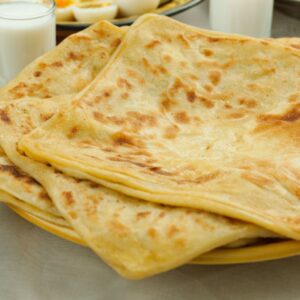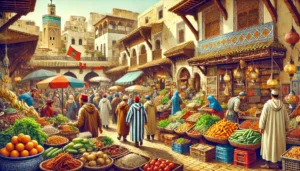Marrakech, the vibrant Red City of Morocco, is not only famous for its bustling souks and stunning architecture but also for its mouthwatering Moroccan cuisine. As a melting pot of Berber, Arab, and Mediterranean influences, Moroccan food is a true feast for the senses. From aromatic tagines to delicate pastries, the best food in Morocco can be found in the winding alleys and hidden restaurants of Marrakech. In this article, we’ll explore the top 5 Moroccan dishes you simply must try when visiting this enchanting city.
1. Tagine: The Heart of Moroccan Cuisine
No discussion of Moroccan cuisine would be complete without mentioning tagine. Named after the conical clay pot in which it’s cooked, tagine is a slow-cooked stew that’s both a cooking method and a dish. The unique shape of the tagine pot allows steam to circulate during cooking, infusing the ingredients with rich flavors and keeping them tender.
In Marrakech, you’ll find countless variations of tagine, but some of the most popular include:
- Chicken tagine with preserved lemons and olives
- Lamb tagine with prunes and almonds
- Vegetable tagine with chickpeas and spices
The key to a perfect tagine lies in its blend of spices, typically including saffron, cumin, cinnamon, and ginger. The slow cooking process allows these flavors to meld together, creating a dish that’s greater than the sum of its parts.
Where to try it: For an authentic tagine experience, head to Dar Zellij, a traditional Moroccan restaurant housed in a beautifully restored riad. Their lamb tagine with prunes and almonds is a standout dish that perfectly showcases the balance of sweet and savory flavors in Moroccan cooking.
2. Couscous: The National Dish of Morocco
Couscous is so integral to Moroccan culture that it’s often referred to as the national dish. This tiny pasta made from semolina wheat is traditionally served on Fridays, the holy day in Islamic countries, but you’ll find it on menus throughout the week in Marrakech.
A traditional couscous dish is typically served with a flavorful stew of vegetables and meat (usually lamb, chicken, or beef) ladled over the top. The couscous itself is steamed to fluffy perfection and often mixed with herbs and spices.
What makes Moroccan couscous unique is the way it’s prepared. The grains are first moistened with water, then rubbed between the palms to separate them. This process is repeated several times, with the couscous steamed between each round, resulting in light, fluffy grains that perfectly absorb the flavors of the accompanying stew.
Where to try it: For a truly memorable couscous experience, visit Al Fassia, a restaurant run entirely by women. Their couscous royale, topped with a variety of meats and vegetables, is a feast for both the eyes and the palate.
3. Pastilla: A Sweet and Savory Delicacy
Pastilla (also spelled bastilla) is a unique dish that perfectly encapsulates the complex flavors of Moroccan cuisine. This savory-sweet pie consists of layers of thin, crispy pastry filled with a mixture of pigeon or chicken, almonds, and eggs, all seasoned with saffron, cinnamon, and fresh coriander. The pie is then dusted with powdered sugar and cinnamon, creating an intriguing blend of flavors and textures.
The origins of pastilla can be traced back to the Andalusian region of Spain, brought to Morocco by the Moors. Over time, it has become a quintessential dish in Moroccan cuisine, often served as a starter or even as a main course.
Where to try it: Dar Moha, a restaurant set in a beautiful garden, offers an excellent chicken pastilla that strikes the perfect balance between sweet and savory flavors.
4. Harira: The Comforting Soup of Morocco
Harira is a hearty soup that holds a special place in Moroccan cuisine, especially during Ramadan when it’s traditionally eaten to break the fast. This thick, tomato-based soup is packed with lentils, chickpeas, and sometimes meat, making it a nutritious and filling meal in itself.
The soup is flavored with a blend of spices including turmeric, cinnamon, ginger, and pepper, and is often finished with a squeeze of lemon juice for brightness. Fresh herbs like cilantro and parsley are also common additions, adding a fresh note to the rich soup.
While harira is especially popular during Ramadan, you can find it year-round in Marrakech, often served with dates and chebakia, a honey-coated sesame cookie.
Where to try it: For a truly authentic harira experience, head to the food stalls in Djemaa el-Fna, Marrakech’s main square, as the sun sets. Here, you can enjoy a steaming bowl of harira alongside locals breaking their fast during Ramadan.
5. Moroccan Mint Tea: The Ritual of Hospitality
While not a dish per se, no list of must-try Moroccan culinary experiences would be complete without mentioning Moroccan mint tea. This sweet, refreshing beverage is more than just a drink – it’s a symbol of Moroccan hospitality and an integral part of daily life.
Moroccan mint tea is made with green tea, fresh mint leaves, and a generous amount of sugar. The tea is traditionally prepared by the head of the household and served to guests in small glasses. The pouring itself is an art form, with the tea poured from a height to create a frothy top.
Where to try it: You’ll find mint tea served everywhere in Marrakech, from high-end restaurants to humble street stalls. For a truly special experience, enjoy a glass at La Mamounia, one of Marrakech’s most luxurious hotels, while taking in the stunning garden views.
Exploring Moroccan Recipes at Home
If you’re inspired by the flavors of Moroccan cuisine and want to try your hand at some Moroccan recipes, here are a few tips to get you started:
- Invest in a tagine pot: While not absolutely necessary, a traditional clay tagine will help you achieve the authentic flavors and textures of Moroccan stews.
- Stock up on spices: Essential spices in Moroccan cooking include cumin, coriander, cinnamon, saffron, and ras el hanout (a spice blend).
- Use preserved lemons: These are a key ingredient in many Moroccan dishes, adding a unique tangy flavor.
- Experiment with sweet and savory combinations: Don’t be afraid to mix fruits like apricots or dates into savory dishes.
- Perfect your couscous technique: Remember to steam the couscous multiple times for the fluffiest texture.
Frequently Asked Questions (FAQ)
To help you navigate the culinary landscape of Marrakech and Moroccan cuisine, here are some commonly asked questions:
Q1: What is the most popular Moroccan dish?
A: While there are many beloved dishes in Moroccan cuisine, tagine is arguably the most popular and widely recognized. This flavorful stew, cooked and served in a conical clay pot, is a staple of Moroccan cooking and can be found in almost every restaurant across Marrakech.
Q2: Is Moroccan food spicy?
A: Moroccan food is more aromatic than spicy. While it uses a variety of spices, the focus is on creating complex, layered flavors rather than heat. However, you may find some dishes accompanied by harissa, a spicy chili paste, which you can add according to your preference.
Q3: What is a traditional Moroccan breakfast?
A: A typical Moroccan breakfast might include khobz (Moroccan bread) with olive oil, jam, or honey, accompanied by Moroccan mint tea. You might also find beghrir (semolina pancakes), msemen (square-shaped pancakes), or eggs served in various ways.
Q4: Are there vegetarian options in Moroccan cuisine?
A: Yes, there are many vegetarian options in Moroccan cuisine. Vegetable tagines, couscous with vegetables, and harira soup can often be prepared without meat. Many salads and side dishes are also vegetarian-friendly.
Q5: What’s a unique Moroccan dish I shouldn’t miss?
A: While not as well-known as tagine or couscous, b’stilla (or pastilla) is a unique Moroccan dish you shouldn’t miss. This sweet and savory pie combines meat (traditionally pigeon, but often chicken in modern versions), almonds, and eggs, wrapped in thin pastry and dusted with powdered sugar and cinnamon.
Q6: Is it safe to eat street food in Marrakech?
A: Street food can be safe to eat in Marrakech if you take some precautions. Look for busy stalls with high turnover, ensure the food is cooked thoroughly and served hot, and avoid raw vegetables or fruits that you can’t peel yourself. The food stalls in Djemaa el-Fna square are popular among both locals and tourists.
Q7: What’s the best way to experience Moroccan cuisine in Marrakech?
A: To truly experience Moroccan cuisine in Marrakech, try a mix of street food, local restaurants, and perhaps a cooking class. Don’t be afraid to venture beyond tourist areas to find authentic local eateries. Also, consider joining a food tour for a guided culinary experience.
Conclusion: A Feast for the Senses
Moroccan cuisine is a true reflection of the country’s rich history and diverse cultural influences. From the complex flavors of a tagine to the comforting warmth of harira, the best food in Morocco offers a culinary journey that tantalizes all the senses.
When visiting Marrakech, be sure to venture beyond the tourist spots and seek out authentic local eateries. Don’t be afraid to try new dishes and flavors – you might just discover your new favorite food. And remember, in Morocco, meals are meant to be savored and shared, so take your time, enjoy the company, and immerse yourself in the rich tapestry of flavors that is Moroccan cuisine.
Whether you’re sampling these dishes in the heart of Marrakech or attempting to recreate them in your own kitchen, the world of Moroccan food is sure to leave you craving more. So embark on your culinary adventure, and let the flavors of Morocco transport you to the bustling souks and serene riads of Marrakech.
Remember, exploring local cuisine is one of the best ways to immerse yourself in Moroccan culture. Don’t hesitate to ask locals for recommendations – Moroccans are often proud of their culinary heritage and happy to share their favorite spots!




